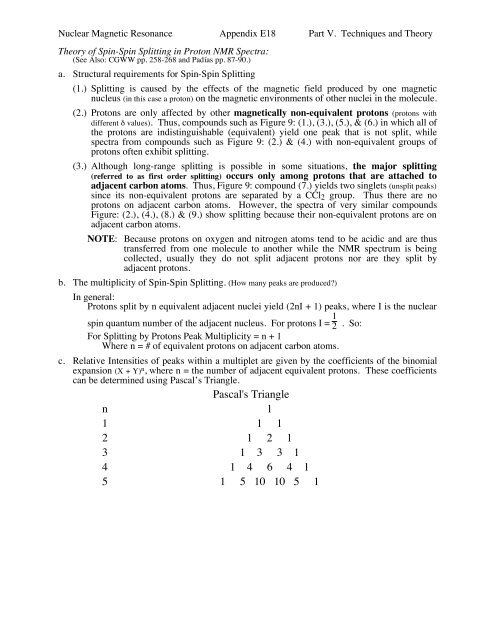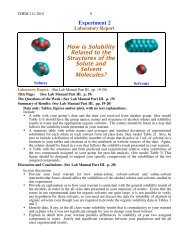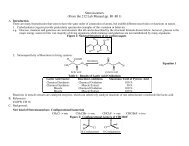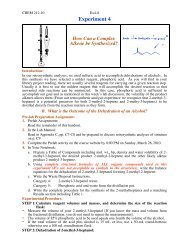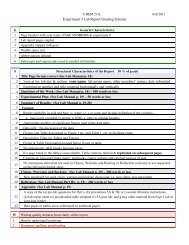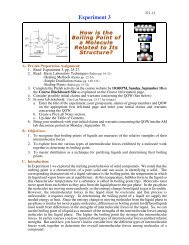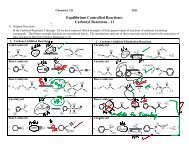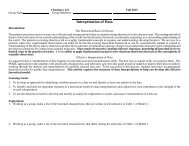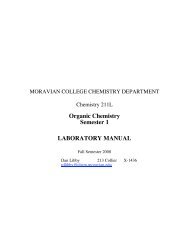Organic Chemistry Semester 1 LABORATORY MANUAL - Moravian ...
Organic Chemistry Semester 1 LABORATORY MANUAL - Moravian ...
Organic Chemistry Semester 1 LABORATORY MANUAL - Moravian ...
Create successful ePaper yourself
Turn your PDF publications into a flip-book with our unique Google optimized e-Paper software.
Nuclear Magnetic Resonance Appendix E18 Part V. Techniques and Theory<br />
Theory of Spin-Spin Splitting in Proton NMR Spectra:<br />
(See Also: CGWW pp. 258-268 and Padías pp. 87-90.)<br />
a. Structural requirements for Spin-Spin Splitting<br />
(1.) Splitting is caused by the effects of the magnetic field produced by one magnetic<br />
nucleus (in this case a proton) on the magnetic environments of other nuclei in the molecule.<br />
(2.) Protons are only affected by other magnetically non-equivalent protons (protons with<br />
different δ values). Thus, compounds such as Figure 9: (1.), (3.), (5.), & (6.) in which all of<br />
the protons are indistinguishable (equivalent) yield one peak that is not split, while<br />
spectra from compounds such as Figure 9: (2.) & (4.) with non-equivalent groups of<br />
protons often exhibit splitting.<br />
(3.) Although long-range splitting is possible in some situations, the major splitting<br />
(referred to as first order splitting) occurs only among protons that are attached to<br />
adjacent carbon atoms. Thus, Figure 9: compound (7.) yields two singlets (unsplit peaks)<br />
since its non-equivalent protons are separated by a CCl 2 group. Thus there are no<br />
protons on adjacent carbon atoms. However, the spectra of very similar compounds<br />
Figure: (2.), (4.), (8.) & (9.) show splitting because their non-equivalent protons are on<br />
adjacent carbon atoms.<br />
NOTE: Because protons on oxygen and nitrogen atoms tend to be acidic and are thus<br />
transferred from one molecule to another while the NMR spectrum is being<br />
collected, usually they do not split adjacent protons nor are they split by<br />
adjacent protons.<br />
b. The multiplicity of Spin-Spin Splitting. (How many peaks are produced)<br />
In general:<br />
Protons split by n equivalent adjacent nuclei yield (2nI + 1) peaks, where I is the nuclear<br />
spin quantum number of the adjacent nucleus. For protons I = 1 2 . So:<br />
For Splitting by Protons Peak Multiplicity = n + 1<br />
Where n = # of equivalent protons on adjacent carbon atoms.<br />
c. Relative Intensities of peaks within a multiplet are given by the coefficients of the binomial<br />
expansion (X + Y) n , where n = the number of adjacent equivalent protons. These coefficients<br />
can be determined using Pascal’s Triangle.<br />
Pascal's Triangle<br />
n 1<br />
1 1 1<br />
2 1 2 1<br />
3 1 3 3 1<br />
4 1 4 6 4 1<br />
5 1 5 10 10 5 1


